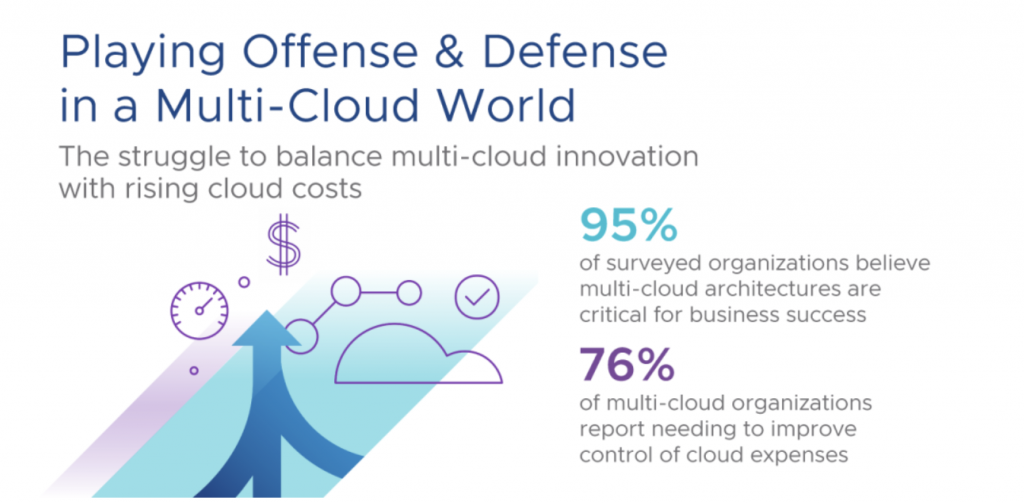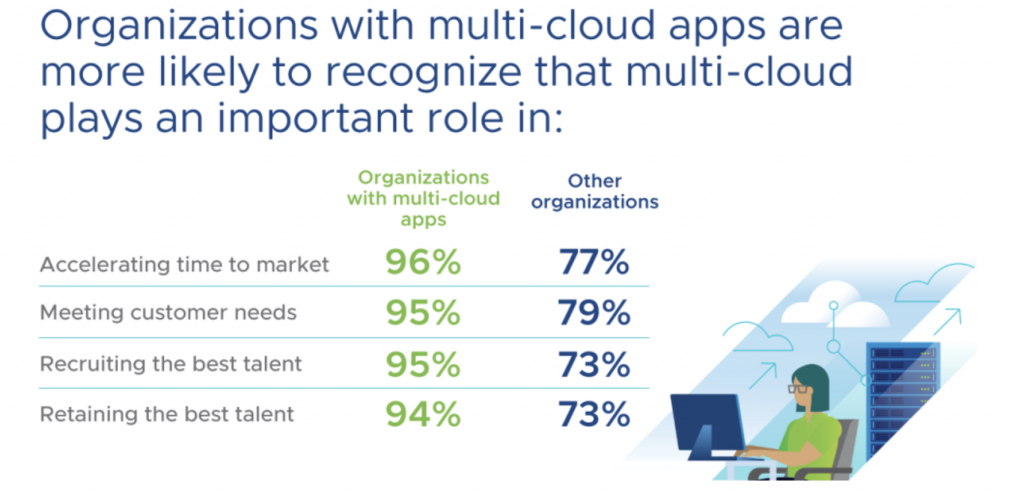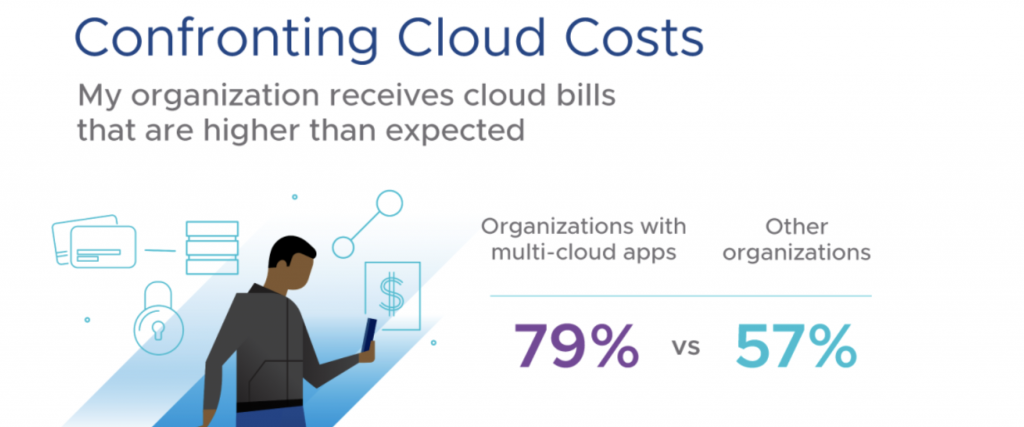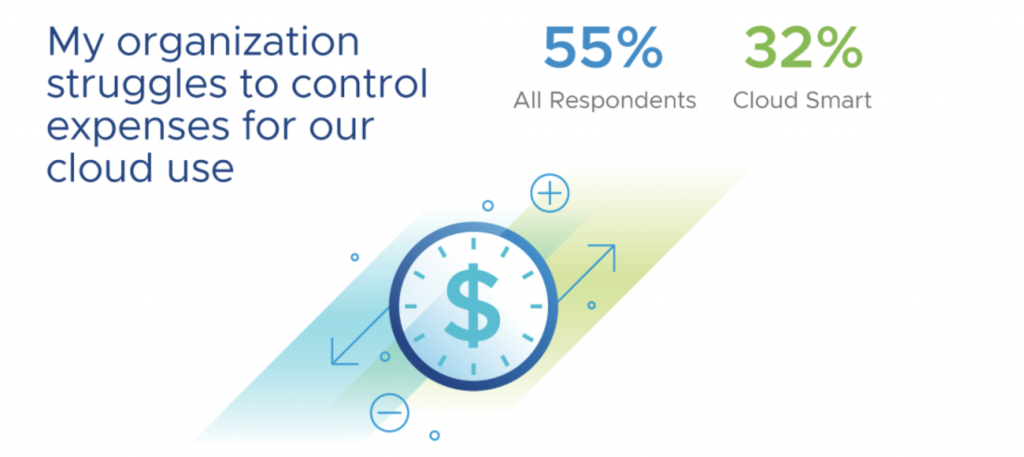Originally posted on http://www.vmware.com
Cloud-smart organizations are out in front in delivering value through multi-cloud apps while controlling cloud costs.

Business leaders today are grappling with a tension that’s inherent to today’s digital economy: They recognize they must continue to drive app-centric innovation in the cloud in order to engage their customers and differentiate from competitors; yet at the same time many organizations are struggling with spiraling cloud costs, which cut into their profitability.
This tension is intensifying as businesses increasingly rely on multiple clouds to run their day-to-day operations. Recent VMware research reveals that 95% of organizations believe multi-cloud architectures are critical for business success. At the same time, 76% of multi-cloud organizations report a need to improve control over their cloud expenses. 1 Simply put, organizations see multi-cloud as critical; but many that have adopted this approach are struggling with the costs.

By contrast, among cloud-smart organizations who are more mature in their multi-cloud operations, only 32% report that they are struggling to control their cloud spend. These findings are captured in The Multi-Cloud Maturity Index Research Report, a global survey of nearly 6,000 organizations conducted by VMware-commissioned market-research firm Vanson Bourne.
Multi-Cloud Goes Mainstream
VMware’s global survey confirms that the multi-cloud model has gone mainstream over the past two years: The organizations surveyed reported a whopping 69% increase in the number of public clouds they rely on to run their day-to-day operations. Within these organizations, app-development teams have been particularly aggressive in embracing multi-cloud; 90% report having “multi-cloud apps” or apps that have the ability to extend across multiple clouds.1

“Rather than looking at public clouds as monoliths (either going all-in on a public cloud and using all of its services or using none of them), app teams are encouraged to compare specific services within clouds and from third parties to see how well they meet their needs,” writes VMware Chief Technology Officer Kit Colbert in Forbes. “The basic precept of the best-in-breed concept is to look at clouds and third parties as simply collections of services that can be mixed and matched as an app team’s needs dictate. This can provide much greater optionality to app teams and allow them to get the best experience and functionality in building and operating their applications.”
Organizations with multi-cloud apps reported a variety of measurable advantages to their multi-cloud approach, including improved time to market, meeting customer needs and recruiting and retaining the best talent:

Confronting Cloud Costs
Leaders recognize that as they increase their investment in app innovation in the cloud, they face greater pressure to control and manage their cloud spend, which increasingly cuts into their profitability while consuming a greater share of their overall IT budget.
According to Gartner®, public cloud services are forecast to grow 18.5% in 2023, up from 17.9% in 2022.2 And recent IDC data shows that 45% of organizations believe they are overspending on cloud and data center infrastructure.3
Organizations surveyed for The Multi-Cloud Maturity Index Research Report concur. Some 79% of organizations that have multi-cloud apps reveal they are grappling with cloud bills that are higher than expected, compared to just 57% organizations who do not have multi-cloud apps.

There are sharp contrasts between organizations dealing with cloud chaos and more mature, sophisticated cloud-smart organizations. A closer look at those grappling with challenges illustrates just how much companies may be missing in terms of financial gains compared to their cloud-smart peers.
A Multi-Cloud App Strategy Benefits from a Cloud-Smart Approach
The end goal of every multi-cloud organization is to maximize the cloud’s inherent scalability for strategic advantage—without letting that scalability spiral into out-of-control spending. Among cloud-smart organizations who are more mature in their approach, only 32% say they are struggling to control their cloud spend.

“CIOs today are evaluating the price tag of cloud’s flexibility and scalability,” says Jason Conyard, VMware CIO and Senior Vice President. “They’re looking for a new approach that provides the control they need to confront rising cloud costs, coupled with the freedom to run services seamlessly across clouds.”
Case in point:
As part of its digital transformation efforts, Japan’s Sawai Group Holdings adopted VMware Aria to ensure proper cost management and security monitoring. This led to a 10% reduction in costs as well as secure operations, with the goal of achieving a 26% reduction in the future.
“The challenges we faced in using the cloud were visualizing the overall costs and security status, and creating a system that was easy to understand and manage, but these seemed difficult to achieve from both a technical and cost perspective. VMware solutions have helped us tackle these challenges quickly and cost-effectively,” says Koji Takeda, General Manager, Group Information Technology Department at Sawai Group Holdings.
“We’ll continue to strive to lower costs and increase security as our cloud utilization expands in scope and look forward to VMware’s continued operational support and advice, enabling us to take full advantage of these tools.”
Koji Takeda, General Manager, Group Information Technology Department, Sawai Group Holdings
Discover how leaders can move from cloud chaos to a cloud smart approach. Visit here.
Visit VMware’s cloud economics resource site to access tools and resources to help get on top of cloud costs. Learn more.








